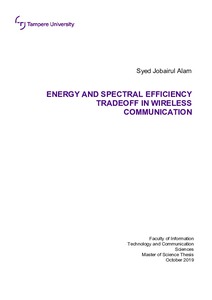Energy and spectral efficiency tradeoff in wireless communication
Alam, Syed Jobairul (2019)
Alam, Syed Jobairul
2019
Sähkötekniikan DI-ohjelma - Degree Programme in Electrical Engineering
Informaatioteknologian ja viestinnän tiedekunta - Faculty of Information Technology and Communication Sciences
This publication is copyrighted. You may download, display and print it for Your own personal use. Commercial use is prohibited.
Hyväksymispäivämäärä
2019-12-03
Julkaisun pysyvä osoite on
https://urn.fi/URN:NBN:fi:tuni-201911145956
https://urn.fi/URN:NBN:fi:tuni-201911145956
Tiivistelmä
In the wireless communication world, a significant number of new user equipments is connecting to the network each and every day, and day after day this amount is increasing with no known bounds. Diverse quality of service (QoS) along with better system throughput are the crying needs at present. With the advancement in the field of massive multiple-input multiple-output (MMIMO) and Internet-of-things (IoT), the QoS is provided smoothly with the limited spectrum by the wireless operator. Hundreds of antenna elements in the digital arrays are set up at the base station in order to provide the smooth coverage and the best throughput within these spectra. However, implementing hundreds of antenna elements with associated a huge number of RF chains for digital beamforming consumes too much energy. Energy efficiency optimization has become a requirement at the present stage of wireless infrastructure. Due to the conflicting nature between the energy efficiency and the spectral efficiency, it is hard to make a balance. This thesis investigates how to achieve a good tradeoff between the energy and the spectral efficiency with maximum throughput outcomes from MMIMO, with the help of existing topologies and a futuristic perspective. Although the signal noise power is less in massive MIMO than the conventional cellular system, it still needs to be decreased and at the same time, the average channel gain per user equipment must be increased. Fixed power requirement for control signaling and load-independent power of backhaul infrastructure must be cut at least by a factor two as well as the power amplifier efficiency has to increase by 10% than LTE networks. The minimum mean square error (MMSE) estimator can be a possible solution in terms of the energy and the spectral efficiency despite having computational complexity which can be solved with the aid of Moore’s law and it is proposed by the non-profit research organization IMEC, which has developed an online web tool for observing and predicting contemporary as well as futuristic cellular base station’s power consumption. It supports various types of base stations with a wide range of operating conditions. The multicell minimum mean square error (M-MMSE) scheme can perform better than other existing schemes and showcase satisfactory tradeoff with frequency reuse factor higher than 2, where regularized zero-forcing (RZF) and maximum ratio (MR) combining fall down their capabilities for performing. With the precipitous rising of IoT, the Narrowband Internet-of-things (NB-IoT) may play an efficient supportive role if we can collaborate it with MMIMO. With its low power, wide area topologies combining with MMIMO technologies can show better tradeoffs. Due to its narrow bandwidth, the signal noise power would be less compared to the existent wideband topologies, and the average channel gain of active user equipment would be higher too. Hence it will give a great impact in terms of the tradeoff between energy and the spectral efficiency which is addressed in this thesis.
